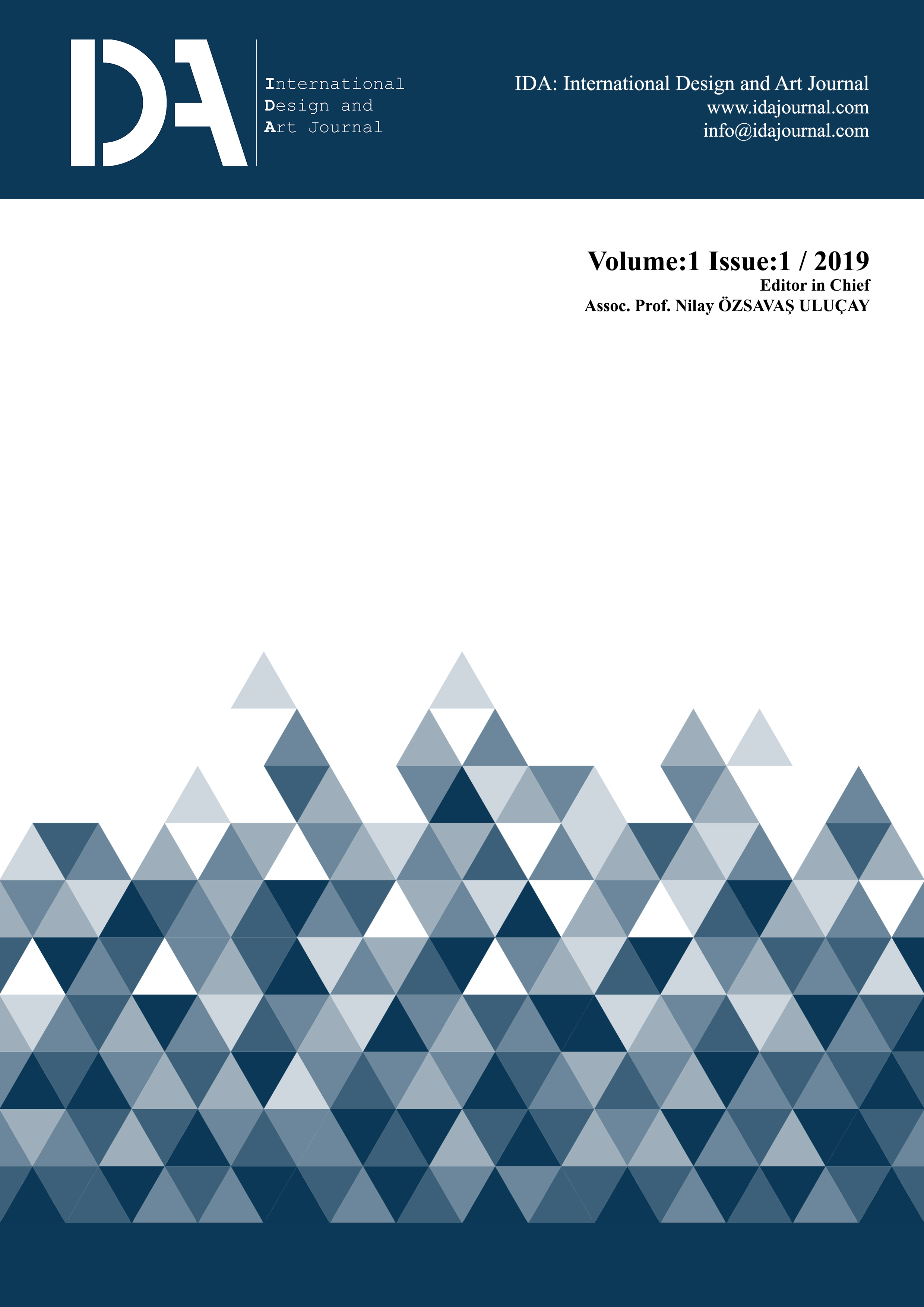Kampüs Alanı İçinde Su Öğesi Kullanımının İşlevsel ve Estetik Niteliklerinin Değerlendirilmesi: Anadolu Üniversitesi Yunus Emre Kampüsü Örneği
Anahtar Kelimeler:
Su- Mekân- İşlevsel- Estetik- KampüsÖzet
Yaşamın pek çok farklı alanında, farklı işlevlerle kendisini gösteren suyun mekân tasarımı üzerinde önemli bir role sahip olduğu bilinmektedir. Su öğesi, geçmişten bugüne hem açık hem de kapalı mekânlarda çeşitli amaçlar için kullanılmıştır. Tarihsel süreç içerisinde, birçok uygarlıkta su, farklı fiziksel ihtiyaç ve eylemlerin karşılanmasının yanı sıra, estetik nitelikleri sembolik değerleri ve anlamlarıyla mekân kimliğini oluşturmada etkili olmuştur. İşlevsellik ve estetik anlamında çeşitlilik gösteren su öğesi, mekân kimliğinde önemli bir rol üstlenmiştir. Su açık mekânların önemli bileşenlerinden birisidir.
Kampüsler hem öğrenciler hem de eğitmenlere, içerisinde yaşam ve aktivite alanı sunan; onların tüm ihtiyaçlarını karşılayabildiği bir sosyal yaşam merkezidir, yerleşkedir. Kampüs planlamasının ilkeleri ve tasarım kararları, pek çok araştırmanın konusu olmakla birlikte, kente uygun bir mekân kimliği taşıması da önemlidir. Eskişehir, içerisinden geçen Porsuk Nehri ile şehir peyzajının bütünleştiği karasal iklime sahip şehirlerden biridir. Bu bakımdan, kent estetiği açısından suyun çok önemli bir öğe olduğu Eskişehir ilinde yer alan en eski kampüs olan Yunus Emre Kampüsünde de açık mekânlarda su öğesinin farklı formlarda ve kullanım biçimleriyle yer aldığı görülmektedir.
Bu çalışmanın kapsamı çalışmanın örneklem alanını oluşturan, suyun kent kimliğinde önemli bir yeri olan Eskişehir’deki en eski kampüs olan Anadolu Üniversitesi Yunus Emre Kampüsü'ndeki açık mekânlardaki yapay su öğeleridir. Çalışmanın amacı; kampüs alanı içinde su öğesi kullanımının işlevsel ve estetik niteliklerinin değerlendirilmesidir. Çalışmada tarama modeli kullanılarak konu ile ilgili literatür taraması yapılmış olup, benzer çalışmalar neticesinde bulunan veriler ile karşılaştırma yöntemi kullanılmıştır Ayrıca, alanda uzman kişilerin görüşlerinden faydalanılarak, tespitler yapılmış, gözlem tekniği kullanılmıştır. Ayrıca veri toplarken kayıt tutma yöntemi olarak not alma ve fotoğraflama tercih edilmiştir. Çalışmanın sonucunda kampüsteki çeşitli su yapıları üzerinden farklı işlevsel ve estetik nitelikleriyle suyun önemli bir kent estetiği öğesi olduğu, Eskişehir ilinde ona kent kimliği ile uyumlu bir kimlik kazandırdığı görülmüştür.
Referanslar
Anayasa (1982). T. C. Resmi Gazete, Kanun 2709, Madde 130. 7 Kasım 1982
Council of Europe (2000). Explanatory Report to the European Landscape Convention. European Treaty Series - No. 176. Florence, 20.X.2000.
Gençtürk, Z. İ., (2006). Meydanlarda su öğesi tasarımı: Sultanahmet ve Beyazıt Meydanları incelemesi. Yüksek Lisans Tezi, İstanbul Teknik Üniversitesi, Fen Bilimleri Enstitüsü, İstanbul.
Gülez, S. (1990). Orman Iiçi rekreasyon potansiyelinin saptanması Iiçin geliştirilen bir değerlendirme yöntemi. İ.Ü. Orman Fak. Dergisi, Seri:A, 40 (2). 132-147
Gürbüz S. ve Karaküçük B. (2007). Rekreasyon ve kentlileşme. Ankara: Gazi Kitabevi.
İlgar, E. (2008). Kent Kimliği ve Kentsel Değişimin Kent Kimliği Boyutu: Eskişehir Örneği, Anadolu Üniversitesi Fen Bilimleri Enstitüsü Mimarlık Ana Bilim Dalı, Yüksek Lisans Tezi, s. 144
Kahraman, M. D. (2014). İnsan ihtiyaçları ve mekansal elverişlilik kavramları perspektifinde yaşanılırlık olgusu ve mekansal kalite. Planlama, 24(2):74-84 doi: 10.5505/planlama.2014.29591
Norberg-Schulz, C. (1971). Existence, space & architecture. Studio Vista: London.
Ragheb, M.G. & Tate, R.L. (1993). A behaviour model of leisure participation based on leisure attitude, motivation and satisfaction. Leisure Studies 12. 61-71.
Sarıçam S. & Coşkun Hepcan Ç. (2015). Porsuk Çayı Adalar Mevkii ve Çevresinin Rekreasyonel Kullanımının Belirlenmesine Yönelik Bir Araştırma. Ege Üniv. Ziraat Fak. Dergisi, 52(1). 1-11
Şengül, E. (1995). Mimari – Su İlişkisi Üzerine Bir İnceleme. Basılmamış Yüksek Lisans Tezi, İstanbul Teknik Üniversitesi, İstanbul.
Tezcan, M. (1982). Sosyolojik açıdan boş zamanları değerlendirme. Ankara: A.Ü Yayınları.
Yerlisu Lapa T, Varol R, Tuncel EF, Ağyar E, Certel Z. (2012). Belediye’ye ait Park Alanlarını Sportif Amaçlı Kullanan Bireylerin Katılımlarının ve Beklentilerinin İncelenmesi: Bornova Örneği, 1. Rekreasyon Araştırmaları Kongresi (851-65), 12-15 Nisan, Antalya, Turkey.
Görsel Kaynakçası
Görsel 1. https://eskisehir.ktb.gov.tr/TR-157965/bilim-sanat-ve-kultur-parki.html. (11.11.2019).
Görsel 2. https://eskisehir.ktb.gov.tr/TR-157963/kent-park.html. (11.11.2019).
Görsel 3. Eren fotoğraf arşivinden (2019).
Görsel 4. Google Haritalar, Sefa Ulum, Anadolu Üniversitesi Yunus Emre Kampüsü Eczacılık Girişi, Haziran, 2018 (12.11.2019).
Görsel 5. https://mapio.net/pic/p-20443745/ (12.11.2019).
Görsel 6. Eren fotoğraf arşivinden (2019).
Görsel 7. Eren fotoğraf arşivinden (2019).
Görsel 8. http://wowturkey.com/t.php?p=/tr348/batusener_auyk2.jpg (11.11.2019).
Görsel 9. Eren fotoğraf arşivinden (2019).
Görsel 10. Eren fotoğraf arşivinden (2019).
Görsel 11. http://wowturkey.com/t.php?p=/tr560/sefer__bayraktar_IMG_4141.jpg (11.11.2019).
Görsel 12. Google Haritalar, Salih Aydın, Japon Bahçesi, Mayıs, 2018; Akın Aksoy, Japon Bahçesi, Mayıs, 2016 (12.11.2019).
Görsel 13. Google Haritalar, Salih Aydın, Japon Bahçesi, Mayıs, 2018; Akın Aksoy, Japon Bahçesi, Mayıs, 2016 (12.11.2019).
Görsel 14. Eren fotoğraf arşivinden (2019).
Görsel 15. Eren fotoğraf arşivinden (2019).
İndir
Yayınlanmış
Sayı
Bölüm
Lisans
IDA: International Design and Art Journal açık erişimli akademik bir dergidir. Kabul edilen makalelerin tüm yayın hakları IDA: International Design and Art Journal'a devredilmiş sayılır. Makaleler başka bir yerde yayınlanamaz, kopyalanamaz ve referans göstermeden kullanılamaz.

IDA: International Design and Art Journal Creative Commons Atıf-GayriTicari-AynıLisanslaPaylaş 4.0 Uluslararası Lisansı ile lisanslanmıştır.


